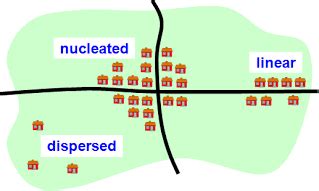Definition of Dispersal

Dispersal, a fundamental concept in AP Human Geography, refers to the process of spreading or distributing people, organisms, or objects across geographic space. It involves the movement of individuals away from their original location and encompasses a wide range of spatial patterns and scales.
Types of Dispersal
1. Clustered Dispersion:
Occurs when individuals or objects are concentrated in specific areas or clusters. This pattern is often observed in urban areas, where people gather for economic opportunities and social connections.
2. Random Dispersion:
Individuals or objects are distributed randomly across the landscape. This pattern is uncommon in nature as living organisms tend to interact and form clusters, but it can occur in artificial environments such as industrial parks.
3. Uniform Dispersion:
Individuals or objects are evenly spaced throughout the area. This pattern is rare in nature as it requires a specific set of environmental conditions, such as regular rainfall and soil quality.
Importance of Dispersal in Human Geography
Dispersal plays a crucial role in shaping human geography. It influences:
- Population Distribution: Patterns of dispersal determine the distribution of population across the globe, from densely populated megacities to sparsely populated rural areas.
- Cultural Diffusion: The spread of ideas, technologies, and practices occurs through dispersal, contributing to cultural diversity and innovation.
- Economic Development: Dispersal of labor and capital can drive economic growth by connecting regions and facilitating trade.
- Environmental Impact: Human dispersal has significant implications for the environment, as it can lead to overpopulation, habitat loss, and pollution.
Factors Affecting Dispersal
Numerous factors influence dispersal patterns, including:
- Physical Barriers: Mountains, oceans, and deserts can hinder dispersal by limiting movement.
- Climate: Extreme weather conditions and harsh environments can restrict the survival and spread of organisms.
- Resources: The availability of food, water, and shelter influences where people and animals choose to disperse.
- Cultural Norms and Beliefs: Social and cultural practices can influence dispersal patterns by determining where people choose to live and work.
- Political Boundaries: International borders and other political divisions can impede or facilitate dispersal.
Applications of Dispersal in AP Human Geography
The concept of dispersal has broad applications in AP Human Geography.
- Urban Planning: Understanding dispersal patterns helps urban planners design cities that optimize accessibility, affordability, and sustainability.
- Migration Studies: Analysis of dispersal patterns provides insights into the motivations and consequences of human migration, including international migration and refugee movements.
- Environmental Conservation: Identifying areas of high dispersal can inform conservation efforts and protect biodiversity.
- Public Health: Tracking disease transmission and spread relies heavily on understanding dispersal patterns.
Conclusion
Dispersal is a fundamental concept in AP Human Geography that explains the distribution and movement of people, organisms, and objects across space. Understanding the factors that affect dispersal and its implications for human geography is essential for shaping sustainable and equitable societies.
